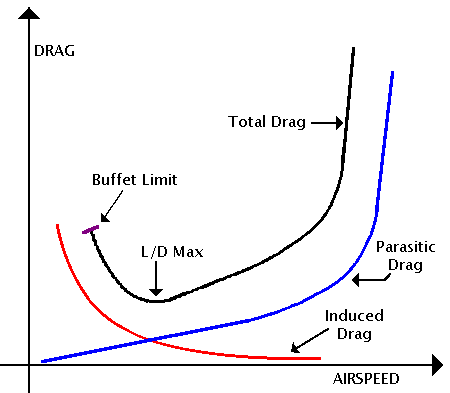
Basic Aerodynamics
Drag comes is two basic flavors. The first, parasitic drag, is very easy to understand as it is simply the resistance of the aircraft to the air through which it moves. Although very difficult to describe in precise mathematical terms, parasitic drag is easily visualized in the difference between a barn door placed at right angles to the wind and an arrow moving through the air or the difference between a person who jumps out of an airplane with and without a parachute. Parasitic drag increases with the square of the speed through the air. The second basic type of drag is less obvious, but very important. This type is called induced drag and is related to the wing's production of lift. The net lift, or aerodynamic force of a wing is produced at right angles to the chord of the wing. Since there must be a positive angle of attack at low airspeed (the angle between the chord and the relative wind) to produce lift, there is a component of the total aerodynamic force which resolves to a vector in the drag direction. This is exactly what is observed in practice - at low airspeed and high angles of attack, induced drag increases and becomes a large factor. The following graph shows the effects of the two types of drag.

This curve, although its precise shape was dictated more by the tool I used to produce it than reality, nonetheless shows the basic effect of the two types of drag. It depicts the condition of an aircraft in level unaccelerated flight over a range of airspeeds. Since the lift in this case is a constant (the weight of the aircraft), the minimum point in the drag curve is the point at which the lift to drag ratio is at its maximum. This point is termed L/D max. Below L/D max, the increase in drag is due to induced drag and above the increase in drag is due to parasitic drag. Airspeeds below L/D max are area known as the region of "reverse command"; that is, as you go slower, you must add more power to overcome the drag. This is somewhat counterintuitive, but an essential part of the aviator's knowledge base. The point labeled "Buffet Limit" is the airspeed at which you have reached the maximum angle of attack and are starting to get the stall buffet. At the high end of the curve, you may actually be limited either by reaching the maximum power output of the engine(s) or reaching the point at which transonic speeds are achieved. As Mach 1 is approached, drag increases dramatically, due to the formation of shock waves. In fact, this is another distinct type of drag known as "wave drag".
As the above discussion indicates, a supersonic aircraft also has to deal with the drag due to the formation of shock waves, the onset of which is influenced by the specific airframe design, but generally starts around .75 Mach. Aircraft designed for supersonic flight power through the high drag of the transonic region and then experience a reduction in drag once established in the supersonic realm. In the transition from subsonic (< .75 Mach), through the transonic region (.75 Mach to 1.3 Mach), and into the supersonic region (> 1.3 Mach), Bernoulli's rules no longer apply and the very nature of lift production changes.
Yet another form of drag is called interference drag. If you take a clean aircraft and determine its drag at a given airspeed and then take an external store like a fuel tank or bomb and measure its drag at the same airspeed, the total drag of the aircraft with the external store attached exceeds the sum of the individual drag values. Interference drag also occurs as a result of external engine nacelles and at the junction of the wing and tail surfaces with the fuselage.
Many of these three dimensional fluid flow problems only recently became candidates for computer analysis as the power of supercomputers has reached a level that make it practical to attempt their analysis. Many of the current high performance aircraft were designed by people gifted with a sense of what would work and what wouldn't. The classic example which comes to mind is Kelley Johnson and his design of the SR-71 at Lockheed's "Skunk Works". Kelley was a very gifted aircraft designer whose mind would be a match for the best Cray has to offer.